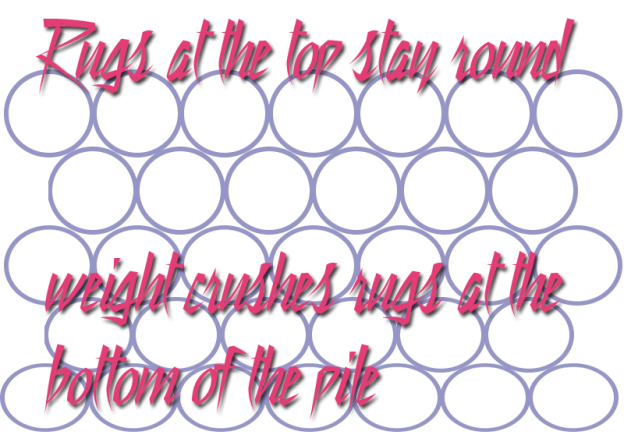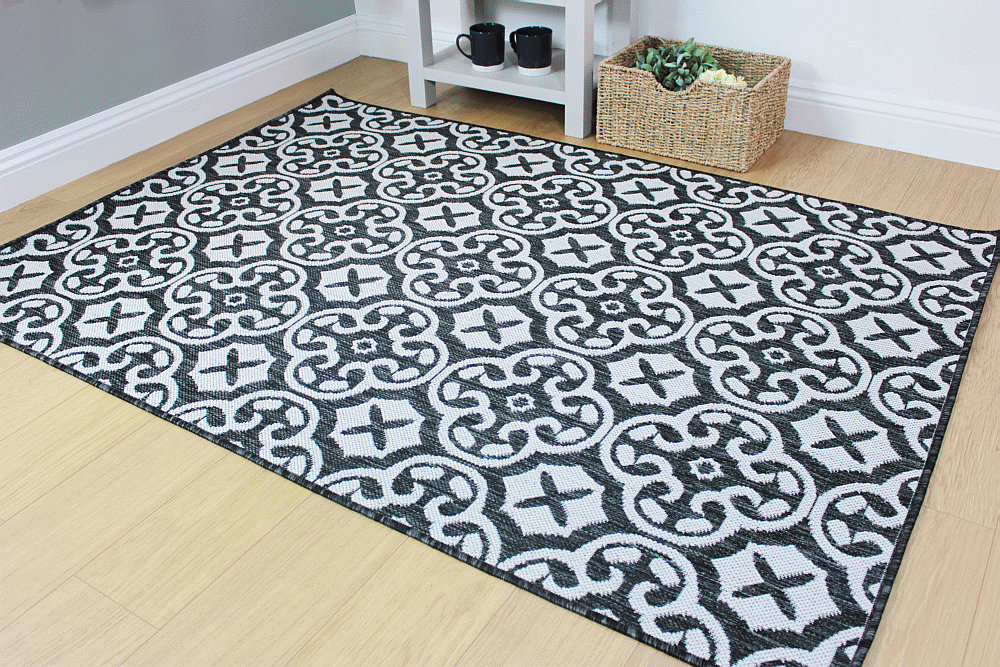How to Remove bumps, ripples and wrinkles from a new rug
It’s a common problem, especially in the winter months, your new rug is delivered, you remove it from the packaging, roll it out and it’s lying wavy on the floor. Why does this happen? In this article we delve into the reasons it happens and solutions to resolve.

When making the rug
The short answer is, to help keep rugs rigid during use in your home, manufacturers of machine-made rugs add an adhesive based stiffener to the backing. Similarly, makers of hand tufted rugs add a secondary backing that is fixed with an adhesive. In both cases the process of applying the adhesive element also helps to obtain better tuft anchorage. But, the very nature of the type of adhesive used, also means the rug can be pliable when warm and rigid when cold. What helps make the rug rigid also causes the the ripples.

Whether the stiffening or backing is applied inside a high-tech factory or outdoors under the warm sun of India, the stiffener or backing process requires heat to accelerate drying. At this point in its finished stage of production the rug will be perfectly flat. The rug, which is still in a warm subtle state is then rolled tightly for transportation. It is normally during transportation where the rug will acquire its undulations.
Transportation from distant lands
Because rugs are bulky, they are generally shipped by sea or overland in containers. The shipping costs to the United Kingdom from major rug producing countries such as Turkey, India and China can prove very costly. Bear in mind, the unit cost of shipping any goods will reflect on the final selling price. Ultimately, It’s the consumer or end user who actually pays the shipping costs. Whether a shipping container is empty or full, it generally costs the same to ship. So, it makes more sense to fill a container to the brim to ensure lower prices for the consumer. It can make a cheap rug, expensive.

When transported, rugs are normally stored lying down and stacked one on top of the other. This is what tends to make the rug take more of an oval shape. Because of the extra weight exerted upon them, rugs on the bottom of the pile are more likely to be crushed and develop a pronounced oval shape.
Alternative methods of storage and shipping?
Some have suggested storing and transporting the rugs in boxes, but putting a cylindrical shaped object in an oblong box means there is no support on the corners. Causing the boxes to be easily damaged. There have even been experiments with ergonomically shaped triangular, Toblerone shaped boxes. The fact is they take up too much space, the extra cardboard packaging would be too expensive and environmentally it’s really an unnecessary use of additional packaging.

Photo by Frans Van Heerden on Pexels.com
Using cardboard or plastic poles in the centre of the rug is another option, again the poles would need to be very heavy and have a fairly large diameter to prevent crushing. Again, this method would give the rug a far greater circumference, reducing the quantity of rugs in the container. Some suppliers do wrap in narrow cardboard or bamboo poles, but this is more common on extra-large rugs and is to stop them bending when being carried.
When rugs arrive in the UK, bulk storage is normally in pallet racking that use smaller bays, so the picker has easier access. The smaller bays also reduce the risk of further crushing.
Opening your rug from the packaging
When first unrolled a new rug will often retain this oval shape and lay on the floor with a slight rippled or concertina effect. Purely down to pressure, it is likely to be more defined at the end of the rug where it has been first rolled. Normally these undulations will settle once the rug is acclimatised to the room. Sometimes they take a little longer and may take a little encouragement to alleviate these unsightly humps.

How to remove ripples on rugs on hard flooring such as wood or tiles.
There are several methods to remove the undulations in a new rug. The basic principle is usually to provide heat to the backing of the rug so it will soften and revert to its natural shape. Here are 4 easy tips to obtain that.
1: Simply reverse roll the rug with pile out, or if you have space roll it diagonally (corner to corner, rather the end to end) and store it overnight preferably somewhere warm, next to a radiator for example, heat will soften the stiffener used on the back of the rug.
2: Place heavy items such as books, boxes or furniture on the rug to flatten it.
3: Lie the rug in direct sunlight, the heat from the sun will soften the backing and it should lie flat.
4: When we photograph rugs, we don’t want to show the undulations and we don’t have time to let the rugs settle naturally, so we iron them flat. If you adopt this method, you will need to lay the rug face down on the floor. You will be able to clearly see offending areas that need attention. Lay a damp towel or cloth on the back of the rug. On a medium hot heat, iron the damp towel or cloth, the heat of the iron will soften the stiffener. You will be able to feel the rug backing become pliable and you’ll find it very easy to gently tease the backing to its natural shape.
WARNING: NEVER IRON THE RUG DIRECTLY IT WILL DAMAGE YOUR RUG AND YOUR IRON.
The lady in the following video would have had a better result if she turned the rug face down and and used the same method on the back of the rug.
If your rug is on a carpet.
The methods for flattening a rug on a carpet are the same as a hard flooring. However, rugs will often show undulations when laid on top of a carpet because they are creeping. This is not the fault of the rug, it will simply move with the nap or pile direction of carpet causing bumps.
If your rug is moving on your carpet please click here to refer an article on why rugs creep on carpet.
To prevent a rug moving on a carpet we recommend Cybergold Anti-Skid / Creep spray. It’s affordable easy to apply and it works.






 Our sample service is unlike our competitors in that
Our sample service is unlike our competitors in that 


















 Thanks to modern manufacture, there are now many opulent and attractive rug designs that emulate the magnificence of the stately homes of rural Britain or the palaces of Persia. Most Persian rugs feature a central medallion with borders on the edge that reflect the design of the central medallion.
Thanks to modern manufacture, there are now many opulent and attractive rug designs that emulate the magnificence of the stately homes of rural Britain or the palaces of Persia. Most Persian rugs feature a central medallion with borders on the edge that reflect the design of the central medallion. If you were looking to maintain a design motif throughout your home, it has never been easier. Taking a three bedroom home with a living room, dining room, hallway and landing, it is possible to have a large and beautiful rug in each room, runners in the hall and landing for less than £350, a budget which would not let you carpet a living room alone.
If you were looking to maintain a design motif throughout your home, it has never been easier. Taking a three bedroom home with a living room, dining room, hallway and landing, it is possible to have a large and beautiful rug in each room, runners in the hall and landing for less than £350, a budget which would not let you carpet a living room alone.